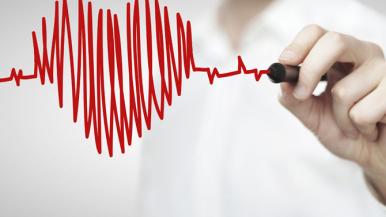Every day, a normal human heart beats about 100,000 times, at an average speed of between 60 and 100 beats per minute. Many things can alter its pace — from aerobic workouts to midnight frights, from fever to cardiac arrest.
Here, Tochi Okwuosa, DO, a cardio-oncology specialist at Rush University Medical Center, brings you up to speed on heart rate and human health.
What makes you tick?
Your heart has two upper and two lower chambers. Within the upper-right chamber is a knoblike group of cells called the sinus node.
Nature's primary pacemaker, the sinus node works 24/7 to keep your ticker beating at the proper pace. It generates electrical impulses that travel along pathways from the top chamber of your heart to the lower ones, sparking the coordinated muscle contractions — heartbeats — necessary to pump blood.
But on any of the pathways in this cardiac conduction system, things can go wrong. "For example, you could have blocks that keep the electrical impulses from getting through or a chaotic rhythm, causing an irregular heartbeat called an arrhythmia," Okwuosa says.
An arrhythmia can cause the heart to beat either too fast or too slow.
Tachycardia: On the fast track
When a heart that doesn't normally speed suddenly starts racing, it's a concern.
Called tachycardia, an abnormally fast rhythm interferes with the heart's pumping ability.
One of the most common types of tachycardia is atrial fibrillation, in which the upper chambers of the heart — the atria — beat in a very rapid, irregular way (fibrillate). When this happens, blood isn't pumped completely out of the chambers. The blood may then pool and form a clot, which can sometimes break away, travel to the brain and trigger a stroke.
The extremely rapid heartbeats of atrial fibrillation can also trigger heart failure, which can cause fluid to back up in the lungs and prevent the heart from sending enough blood to the rest of the body.
Bradycardia: Slower than normal
Abnormally slow heart rates of less than 60 beats per minute — bradycardia — can be either harmless or potentially life-threatening.
"If your heart rate is in the 50s, we usually don't worry unless you have certain symptoms that your heart and brain aren't getting enough blood, and that can be dangerous," Okwuosa says.
Those symptoms include dizziness, shortness of breath, chest pains, feeling faint or actually fainting.
Heart rate is a marker of health, so it's good to know your resting heart rate — or how fast your heart beats when you aren't exercising.
What else can affect your heart rate?
- Heat. In hot, humid weather, your heart beats a little faster — perhaps five to 10 beats per minute faster — to get more blood to the skin, which helps cool you down. In extreme heat, rapid pulse is a symptom of two dangerous conditions: heat exhaustion and heatstroke. Learn more about the symptoms and causes of heat illnesses.
- Fever. Studies show a fever raises your heart rate by eight to 10 beats per minute for every 1.8 degrees above 98.6. "Your heart is sending more blood to help your body deal with the illness," Okwuosa says.
- Emotions. Anything that excites you — whether it's love or fear — causes your sympathetic nervous system to rev up the beta receptors in your heart so it beats harder and faster.
- Sleep. When you're sleeping, your parasympathetic nervous system lowers your heart rate, since resting organs need less blood flow to keep working.
- Dreams. During REM sleep, your heart may speed up, slow down or do both — perhaps in response to your dreamland adventures.
- Medicines. Beta-blockers may slow your heart down because they block adrenaline. By contrast, thyroid medication can speed your heart up if the dose is too high.
Hit your target
Exercise can help condition your heart and lower your heart rate. Okwuosa recommends starting off slowly, however, if you're new to working out. "Aim to exercise at 50 percent of your target heart rate," she says. You can gradually increase that percentage as you become more fit.
To calculate your target heart rate, deduct your age from 220. Multiply the result by 0.85.
Resting heart rate: A quick calculation of health
"Heart rate is a marker of health, so it's good to know your resting heart rate — or how fast your heart beats when you aren't exercising," says Okwuosa.
To check yours, you'll need a timer or a watch with a second hand. Then, do the following:
- Sit and relax for 15 minutes to let your heart settle into its natural rate.
- Place the tips of your index and middle fingers of one hand on the inside of the opposite wrist, below the thumb. Press firmly to feel your radial pulse.
- For 15 seconds, count the number of beats.
- Multiply that number by four to get your resting heart rate.
| Your resting heart rate | What it means | What to do |
|---|---|---|
| Below 60 for a conditioned athlete | Normal | Keep exercising — your heart is happy! |
| Below 60 for a nonathlete | Usually not a problem, though it sometimes signals a serious condition | Tell your doctor — especially if you feel dizzy or faint |
| 60 to 100 | Normal | Take good care of your heart with diet and exercise. |
| 95 to 100 | Still normal — but your heart might benefit from more exercise | Try increasing how often or hard you work out. |
| Over 100 for no apparent reason (like exercising) | Could signal a serious or even life-threatening problem |
See your doctor, especially if you also have any of the following:
|




